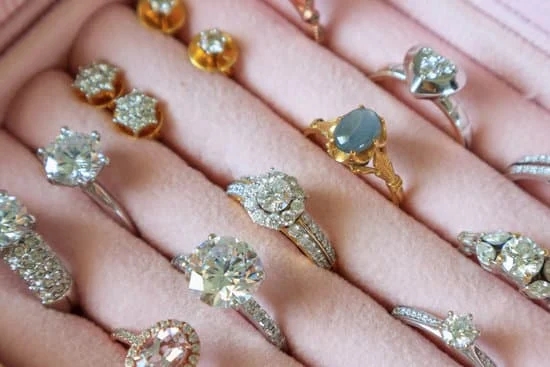The history of jewelry making on Ponte Vecchio spans centuries, making this iconic bridge in Florence, Italy a must-see destination for jewelry enthusiasts and history buffs alike. As one of the oldest bridges in Florence, Ponte Vecchio has stood the test of time and witnessed the evolution of jewelry making throughout its rich history.
Originally built during the Roman times, Ponte Vecchio has been a historical landmark for over 2,000 years. The bridge has not only served as a crossing point over the Arno River, but it has also been a hub for commerce and craftsmanship. Today, Ponte Vecchio is best known for its historic role in the jewelry industry, with shops lining the bridge selling exquisite pieces of craftsmanship.
The evolution of jewelry making on Ponte Vecchio reflects not only changes in fashion and style but also the influence of notable jewelers who have left their mark on this iconic location. From the impact of the Medici family to the resilience shown in the face of historical events, Ponte Vecchio stands as a testament to the enduring legacy of jewelry making. Join us as we explore the fascinating history and lasting legacy of jewelry making on Ponte Vecchio.
The Early Years
Located in the heart of Florence, Italy, Ponte Vecchio is one of the most iconic and historically significant landmarks in the city. Its origins can be traced back to Roman times, making it not only a symbol of architectural beauty but also a testament to the rich history of Florence. The bridge has withstood various historical events, including wars and natural disasters, which have contributed to shaping its identity as a significant historical landmark.
Roman Origins
Ponte Vecchio, which translates to “Old Bridge” in Italian, was first built during Roman times. Originally constructed in wood, it was later rebuilt in stone by the Romans. The bridge served as an essential crossing over the Arno River and played a crucial role in connecting the two sides of the city.
The Butchers’ Bridge
During medieval times, Ponte Vecchio became known for hosting butcher shops along its edges. This unique feature was due to a decree by Cosimo I de’ Medici in 1593 that ordered all butcher shops to be moved from the bridge because of sanitary concerns. This paved the way for another type of commerce that would ultimately define Ponte Vecchio’s identity: jewelry making.
The Transition to Jewelry Making
Following the expulsion of butcher shops from Ponte Vecchio, it became home to goldsmiths and jewelers who set up their businesses along the bridge. This marked a turning point in its history and cemented its reputation as a hub for jewelry making. The evolution from hosting butchers to being renowned for high-quality craftsmanship represents an important chapter in the history of jewelry making on Ponte Vecchio and continues to contribute to its allure as an international tourist destination.
The Evolution of Jewelry Making on Ponte Vecchio
Ponte Vecchio has long been associated with the art of jewelry making, dating back to its early years in history. The evolution of jewelry making on Ponte Vecchio reflects the rich tradition and craftsmanship that has been passed down through generations. From its humble beginnings to becoming a renowned destination for exquisite jewelry, the bridge has played a significant role in shaping the history of jewelry making in Florence.
Historical Significance of Ponte Vecchio
The history of jewelry making on Ponte Vecchio is intertwined with the historical significance of the bridge itself. Dating back to Roman times, Ponte Vecchio has stood as a symbol of resilience and innovation. It has survived wars, floods, and architectural changes, yet it remains an iconic landmark that attracts both locals and tourists alike.
The Renaissance Period and Jewelry Making
During the Renaissance period, Ponte Vecchio became a hub for skilled artisans and jewelers. The Medici family’s patronage of the arts further elevated the status of the bridge as a center for creativity and craftsmanship. Jewelers set up shops along the bridge, showcasing their intricate designs and exquisite pieces, attracting patrons from near and far.
Influence of Traditions on Modern Jewelry Making
The traditions established during the Renaissance period continue to influence modern jewelry making on Ponte Vecchio. Artisans pay homage to centuries-old techniques while incorporating contemporary elements into their designs. Visitors can witness this blend of tradition and innovation as they explore the various jewelry shops that line the bridge today.
As time progresses, Ponte Vecchio remains a timeless symbol of craftsmanship and creativity in the world of jewelry making. The legacy of its early jewelers lives on, ensuring that this historic landmark continues to be a celebrated destination for those who appreciate fine craftsmanship.
Famous Jewelers and Their Legacy on Ponte Vecchio
Ponte Vecchio has a rich history as a historical landmark in the city of Florence, Italy. The bridge has been a hub for jewelry making for centuries and has seen the rise of many famous jewelers who have left a lasting legacy on this iconic location.
One such legendary figure is Benvenuto Cellini, an Italian goldsmith, sculptor, draftsman, soldier, musician, and artist who was known for his exquisite work in the field of jewelry making. Cellini’s contributions to Ponte Vecchio and the art of jewelry making are invaluable and continue to influence contemporary artisans.
Another renowned jeweler with a lasting legacy on Ponte Vecchio is Stefano Ricci. His eponymous luxury brand has gained global recognition for its high-quality craftsmanship and innovative designs. Ricci’s atelier on Ponte Vecchio reflects the bridge’s enduring status as a center for artisanal expertise and creativity in the realm of luxury jewelry.
In addition to these prominent figures, there are numerous other jewelers who have contributed to the legacy of Ponte Vecchio through their distinctive styles and exceptional craftsmanship. Their creative innovations have added to the allure and prestige of this historical site as a symbol of artistry and excellence in the world of jewelry making.
Through their dedicated work, these jewelers have helped shape the identity and reputation of Ponte Vecchio as a distinguished destination for jewelry enthusiasts from around the globe.
| Famous Jewelers | Legacy |
|---|---|
| Benvenuto Cellini | Invaluable contributions and influences contemporary artisans |
| Stefano Ricci | Global recognition for high-quality craftsmanship and innovative designs |
The Impact of the Medici Family on Jewelry Making
The history of jewelry making on Ponte Vecchio would not be complete without mentioning the significant impact of the Medici family. The Medici dynasty, known for their patronage of the arts and support of talented artisans, played a pivotal role in shaping the jewelry industry on this iconic bridge.
During the Renaissance period, the Medici family held immense power and influence in Florence, and their support for goldsmiths and jewelers led to a flourishing of craftsmanship on Ponte Vecchio. They commissioned exquisite pieces of jewelry as gifts for foreign dignitaries, enhancing the reputation of the city as a center for luxury goods.
The legacy of the Medici family can still be seen today in the architecture and design of the buildings on Ponte Vecchio, as well as in the techniques and styles passed down through generations of jewelers. Their contribution to the development of jewelry making on Ponte Vecchio is undeniable, and their influence continues to inspire artisans and visitors alike.
The impact of the Medici family on jewelry making on Ponte Vecchio can be summarized in the following points:
- Patronage of talented goldsmiths and jewelers
- Commissioning exquisite pieces for diplomatic gifts
- Shaping the reputation of Florence as a center for luxury goods
The Resilience of Ponte Vecchio in the Face of Historical Events
Throughout its long history, Ponte Vecchio has faced numerous historical events that could have potentially threatened its existence. However, this iconic bridge has shown remarkable resilience in the face of these challenges, proving itself to be not only a symbol of architectural beauty but also a testament to the endurance of craftsmanship and trade.
One of the most significant challenges that Ponte Vecchio faced was during World War II when Florence came under German occupation. Despite the destructive forces at play during this time, Ponte Vecchio miraculously survived the war largely unscathed.
The bridge’s survival is attributed to an order given by Adolf Hitler himself to spare it from destruction due to its historical significance. This preservation amid chaos speaks volumes about the enduring importance of Ponte Vecchio as a cultural and economic landmark.
Despite surviving one historical event after another, including floods and fires throughout the centuries, Ponte Vecchio has always managed to rise from the ashes like a phoenix. Its steadfast presence today serves as a reminder of the resiliency of not only the bridge itself but also of the craft of jewelry making that has thrived upon it for centuries.
- The preservation efforts made over time
- The impact of World War II on Ponte Vecchio
- The symbolism behind Ponte Vecchio’s survival despite historical events
Modern Day Jewelry Making on Ponte Vecchio
In modern times, Ponte Vecchio continues to be a hub for jewelry making and a landmark of historical and cultural significance. Today, the bridge is lined with numerous jewelry shops, showcasing exquisite pieces crafted by local artisans. These artisanal jewelers not only carry on the traditions of their predecessors but also incorporate contemporary techniques and designs, creating a blend of old-world charm and modern elegance.
The craftsmanship of the jewelry makers on Ponte Vecchio is renowned worldwide, with each piece reflecting the skill and artistry that has been passed down through generations. Visitors to the bridge have the opportunity to witness these artisans at work in their workshops, providing insight into the meticulous process of creating fine jewelry. From intricate goldsmithing to the setting of precious gemstones, the techniques employed by these artisans uphold the legacy of Ponte Vecchio as a center for exceptional craftsmanship.
Moreover, Ponte Vecchio has adapted to modern demands without compromising its historical significance. While traditional styles remain prevalent, contemporary jewelry designers have also set up studios on the bridge, offering innovative and avant-garde pieces that appeal to a diverse clientele. This harmonious integration of tradition and innovation ensures that Ponte Vecchio remains a must-visit destination for aficionados of fine jewelry from around the world.
| Modern Day Jewelry Making | Ponte Vecchio |
|---|---|
| Ponte Vecchio carries on as a hub for contemporary jewelry making | Blend of old-world charm & modern elegance |
| The craftsmanship reflects skill & artistry passed down through generations | Visitors can witness artisans at work in their workshops |
| Ponte Vecchio’s adaptation to modern demands maintains its historical significance | Traditional styles alongside innovative designs cater to diverse clientele |
The Tourist Experience
In conclusion, the history of jewelry making on Ponte Vecchio is a rich and storied one, dating back to the early years of this historical landmark. From its origins as a simple bridge to its evolution into a bustling hub of jewelry making, Ponte Vecchio has witnessed the rise of famous jewelers and the enduring legacy of the Medici family.
Despite facing numerous historical events, Ponte Vecchio has stood the test of time and continues to be a symbol of resilience and strength.
Today, visiting Ponte Vecchio offers tourists a unique opportunity to not only appreciate stunning pieces of jewelry but also to immerse themselves in the fascinating history behind them. The bridge is lined with an array of shops that showcase exquisite craftsmanship and design, allowing visitors to marvel at the timeless beauty of jewelry making.
Whether it’s exploring the traditional artisan workshops or admiring modern creations, a visit to Ponte Vecchio promises an unforgettable experience for anyone with an appreciation for jewelry.
For those seeking a deeper understanding of the history of jewelry making on Ponte Vecchio, guided tours are available to provide insight into the bridge’s significance and its role in shaping Florence’s cultural heritage. These tours offer a chance to gain a comprehensive understanding of how Ponte Vecchio has played a pivotal role in the development of jewelry making in Florence and beyond.
Whether it’s delving into the stories behind famous jewelers or learning about the Medici family’s influence, tourists can truly appreciate the unique intersection of history and art that defines Ponte Vecchio.
Frequently Asked Questions
What Is the Historical Significance of Ponte Vecchio?
The historical significance of Ponte Vecchio lies in its status as the oldest bridge in Florence, Italy. Originally built during Roman times, it has played a crucial role in the city’s history and development.
What Is the Famous Jewelry Bridge in Florence?
The famous jewelry bridge in Florence is none other than Ponte Vecchio itself. The bridge is home to various shops selling gold, silver, and other jewelry, making it a popular destination for visitors seeking unique pieces of craftsmanship.
What Is the Secret of Ponte Vecchio?
The secret of Ponte Vecchio lies in its hidden Vasari Corridor, an elevated enclosed passageway used by the Medici family to move between their residence and the government buildings without having to mix with the general public. This secret passage is a fascinating aspect of the bridge’s history and adds to its mystique.

Welcome to my jewelry blog! My name is Sarah and I am the owner of this blog.
I love making jewelry and sharing my creations with others.
So whether you’re someone who loves wearing jewelry yourself or simply enjoys learning about it, be sure to check out my blog for insightful posts on everything related to this exciting topic!





